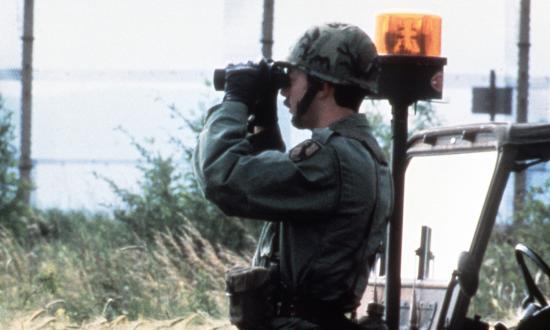The U.S. Coast Guard should grow its partnership with the U.S. Naval Sea Cadet Corps. Sea Cadets is a Navy- and Coast Guard-supported program that teaches patriotic young Americans ages 10 to 18 about the military and U.S. maritime operations. Through monthly weekend drills and week-long advanced training during school breaks, community service, discipline, and teamwork, this youth program produces high-quality leaders, 59 percent of whom pursue military service.1
The Coast Guard is a strong supporter of the Sea Cadets, but it may be missing an opportunity to maximize the program’s potential as a cost-effective pipeline for future recruits. Many of the approximately 6,000 young men and women enrolled in the Sea Cadets are predisposed to choose careers at sea. In fact, a 2023 survey of 396 graduating cadets found 42 planned to join the Coast Guard. The service could help build this number by exposing cadets to its exciting opportunities.
Add Training Opportunities
Of the 427 Sea Cadet training opportunities for summer 2023, 47 were Coast Guard sponsored or related.2 The small boat stations at Bodega Bay and Golden Gate are examples of a relatively easy, mission-supporting way for the Coast Guard to reach more cadets.
The two stations each provide 14 weeks of training from Memorial Day to Labor Day. This gives up to two (Bodega Bay) or four (Golden Gate) cadets the chance to live at the station and serve as part of the crew, in the same capacity as non-rate Coasties or Coast Guard Academy cadets on summer tours. They learn about the service’s missions, help with maintenance, build camaraderie, and assist on cases as they happen. This format is enticing, because it is an internship-style opportunity that looks good on a college or job application or for future enlistment. And according to the Coast Guard recruiting manual, individuals who spend at least nine months in Sea Cadets may be eligible to enlist at an advanced pay grade (E-2 or E-3).3
Training opportunities like these have a positive effect. Jeremy Rodrigues, a former member of Sea Cadets, had the opportunity to go on board the USCGC Munro (WHEC-724) in 2000. Seventeen at the time, Jeremy had the option to stay on board for one week, two weeks, or the summer. He remained on the cutter for the summer, disembarking after completing an Alaska patrol. While on board, Jeremy performed so well the Munro’s commanding officer wrote his parents: “I’m sure you will understand when I pay this compliment: I kept forgetting he was aboard!”
Jeremy enlisted in the Coast Guard and subsequently attended Officer Candidate School in 2007. He retired from the Reserve in 2021, after 20 years of service. He credits his successes in the Coast Guard to experiences that began on the Munro.
Opening more cutters, small-boat stations, and air stations to host Sea Cadets for a week or more would give more ambitious, military-minded high school students exposure to the Coast Guard. Putting four cadets at 25 stations, for example, would give 100 young Americans (as many as 60 of whom would be likely to joint the military) the chance to experience service life and culture firsthand—which could be the deciding factor in choosing a Coast Guard career.
Sea Cadets is a diverse program, with cadets dispersed across the country. Providing training in multiple locations also would give more cadets a chance to participate without incurring expensive transportation costs. Many youth who might be interested in attending training at Golden Gate or Bodega Bay cannot compete for a spot because their families cannot afford the travel costs. Opening more locations for training would increase the Coast Guard’s reach among Sea Cadets across the country.
The authorization already exists, as explained in the Coast Guard External Affairs Manual, which notes that Sea Cadets is “the primary youth program the Coast Guard supports” and that Sea Cadets may “use training and recreation facilities at Coast Guard facilities and participate in Coast Guard cruises and air operations at the discretion of the commanding officer or officer-in-charge, with approval of the district commander.”4
Use Recruiters to Advocate
The Coast Guard also could have recruiters refer to the Sea Cadets middle school and high school students who express interest in enlisting but are too young to join the Delayed Entry Program (DEP). Sea Cadets can help them gain experience as they mature and keep them motivated to serve until they can join. High schoolers in DEP could be referred to Sea Cadets to get a head start in the basics of military service—from improving physical fitness to learning military discipline—and to stay motivated before shipping to boot camp.
Low Cost, Big Returns
Enlisting or commissioning Sea Cadets into the Sea Services improves the quality of recruits and saves money on recruiting. These young men and women are less likely to wash out of training because they already have experienced military discipline and have a better understanding of what they are signing up for. Former Chief of Naval Operations Admiral Gary Roughead estimated each cadet who enlists saves the Navy more than $14,000 in life-cycle training costs.5 The same is likely true for the Coast Guard.
Simple steps that could strengthen the Coast Guard–Sea Cadet partnership at little cost and minimal mission disruption could boost recruiting. In its more than 60-year history, Sea Cadets has helped build leaders of character, including Vincent W. Patton III, Eighth Master Chief Petty Officer of the Coast Guard. The Coast Guard should expand its efforts to connect with these young leaders.
1. U.S. Naval Sea Cadets, 2021 Annual Report (Arlington, VA: USNSCC, 2022), 31, issuu.com/seacadets.org/docs/2021_sea_cadets_annual_report.
2. Internal Sea Cadet training data.
3. U.S. Coast Guard, Coast Guard Recruiting Manual (Washington, DC: Headquarters U.S. Coast Guard, August 2021), 3-1–3-3.
4. U.S. Coast Guard, External Affairs Manual (Washington, DC: Headquarters U.S. Coast Guard, May 2021), 5-21.
5. Yorktown Division, USNSCC, “What We Do,” www.yorktownseacadets.org.










